Draw a Tree Diagram to Represent the Possible Outcomes
Related Pages
Tree Diagrams
More Lessons On Probability
Probability Worksheets
Theoretical And Experimental Probability
What Is A Probability Tree Diagram
We tin can construct a probability tree diagram to help us solve some probability bug.
A probability tree diagram shows all the possible events. The first event is represented by a dot. From the dot, branches are drawn to represent all possible outcomes of the upshot. The probability of each effect is written on its co-operative.
Example:
A bag contains 3 black assurance and five white assurance. Paul picks a ball at random from the bag and replaces it back in the pocketbook. He mixes the balls in the bag and then picks another ball at random from the handbag.
a) Construct a probability tree of the problem.
b) Calculate the probability that Paul picks:
i) two black assurance
ii) a blackness ball in his second draw
Solution:
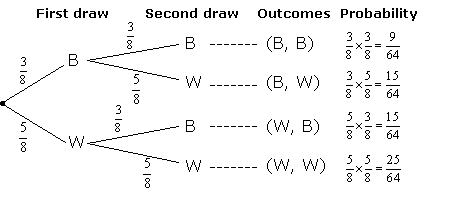
a) Cheque that the probabilities in the terminal column add up to 1.
![]()
b) i) To find the probability of getting two blackness balls, first locate the B branch and so follow the 2d B co-operative. Since these are independent events we can multiply the probability of each branch.
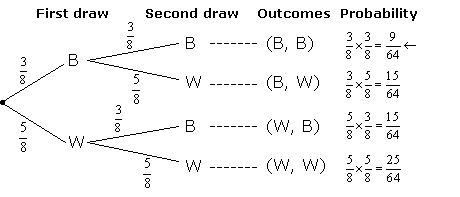
![]()
ii) In that location are ii outcomes where the second ball can be black, either (B, B) or (W, B)
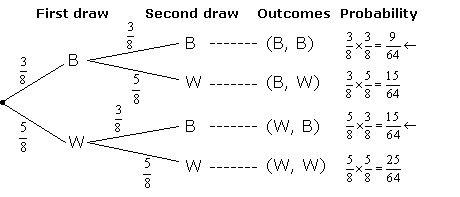
From the probability tree diagram, we get:
![]()
P(second ball black)
= P(B, B) or P(Westward, B)
= P(B, B) + P(West, B)

Example:
Bag A contains 10 marbles of which 2 are red and 8 are blackness. Bag B contains 12 marbles of which 4 are red and 8 are black. A brawl is drawn at random from each bag.
a) Describe a probability tree diagram to show all the outcomes the experiment.
b) Notice the probability that:
(i) both are reddish.
(ii) both are black.
(iii) i black and one ruby-red.
(iv) at least one cherry-red.
Solution:
a) A probability tree diagram that shows all the outcomes of the experiment.
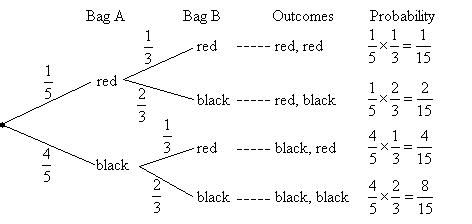
b) The probability that:
(i) both are red.
P(R, R) = ![]()
(ii) both are black.
P(B, B) = ![]()
(iii) 1 blackness and i red.
P(R, B) or P(B, R) = ![]()
(iv) at to the lowest degree one red.
1 - P(B, B) = ![]()
Example:
A box contains iv red and two blue fries. A flake is drawn at random and and so replaced. A second chip is and then drawn at random.
a) Show all the possible outcomes using a probability tree diagram.
b) Calculate the probability of getting:
(i) at to the lowest degree one blue.
(ii) one cerise and one blue.
(3) two of the same color.
Solution:
a) A probability tree diagram to bear witness all the possible outcomes.
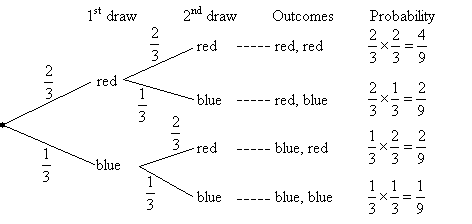
b) The probability of getting:
(i) at least ane blue.
P(R, B) or P(B, R) or P(B, B) = ![]()
(ii) one red and 1 blueish.
P(R, B) or P(B, R) = ![]()
(iii) 2 of the aforementioned color.
P(R, R) or P(B, B) = ![]()
Probability Tree Diagrams For Contained Events
How To Solve Probability Problems Using Probability Tree Diagrams?
Example:
A coin is biased so that it has a sixty% chance of landing on heads. If information technology is thrown three times, find the probability of getting
a) three heads
b) 2 heads and a tail
c) at least one caput
- Prove Video Lesson
How To Use A Tree Diagram To Calculate Combined Probabilities Of Two Independent Events?
Case:
Jenny has a pocketbook with seven bluish sweets and 3 red sweets in information technology. She picks up a sweetness at random from the handbag, replaces it and so picks again at random. Draw a tree diagram to represent this situation and utilize it to calculate the probabilities that she picks:
(a) 2 red sweets
(b) no carmine sweets
(c) at least 1 bluish sweet
(d) one sweet of each color
- Show Video Lesson
Probability Tree Diagrams For Dependent Events
How To Utilize A Probability Tree Diagram To Summate Probabilities Of Two Events Which Are Not Independent?
Example:
Jimmy has a bag with seven blue sweets and 3 red sweets in it. He picks up a sweetness at random from the purse, but does not replaces information technology and so picks once again at random. Draw a tree diagram to represent this situation and utilise information technology to summate the probabilities that he picks:
(a) two red sweets
(b) no red sweets
(c) at to the lowest degree one blueish sweet
(d) one sweet of each color
- Testify Video Lesson
How To Use A Probability Tree Diagram To Calculate Probabilities Of Two Events Which Are Dependent?
Example:
Inside a purse there are three green balls, 2 carmine balls and and four yellow balls. Two balls are randomly fatigued without replacement. Calculate the probability of cartoon one red ball and one xanthous brawl.
- Show Video Lesson
Try the free Mathway calculator and problem solver below to practise diverse math topics. Attempt the given examples, or type in your own trouble and check your respond with the step-by-footstep explanations.
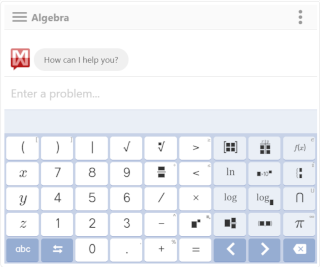
We welcome your feedback, comments and questions nearly this site or page. Delight submit your feedback or enquiries via our Feedback folio.
Source: https://www.onlinemathlearning.com/probability-tree-diagrams.html
0 Response to "Draw a Tree Diagram to Represent the Possible Outcomes"
ارسال یک نظر